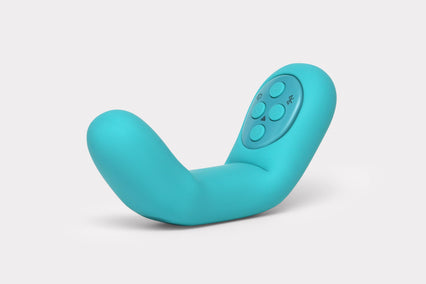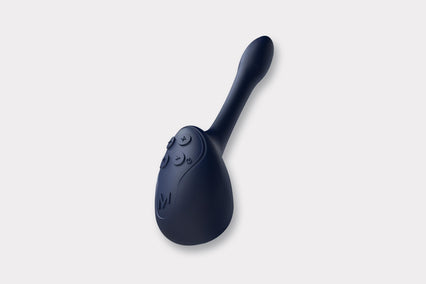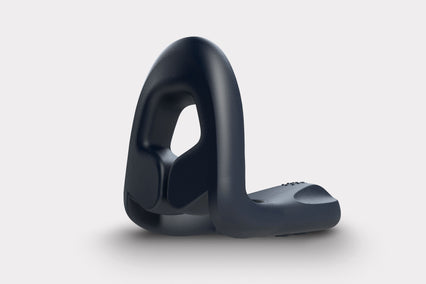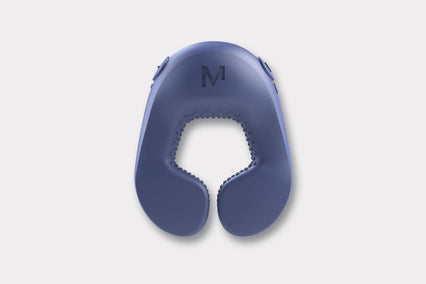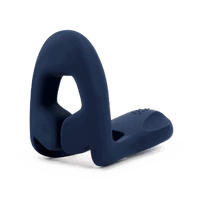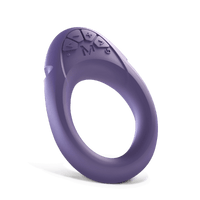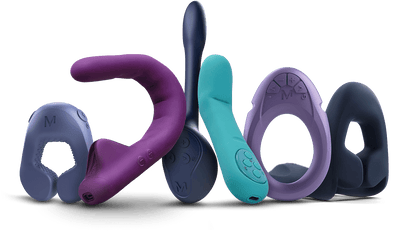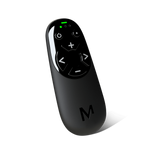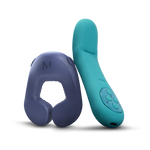If pelvic pain or discomfort during sex has you feeling stuck, you're not alone. Pelvic wands can genuinely help, but figuring out exactly what to do with one isn't always obvious (or comfortable to ask about). Below, we’ll walk you through straightforward, no-nonsense steps to get started, explain exactly how a pelvic wand works, and highlight the benefits of a pelvic wand for pelvic tension, improving intimate comfort, and restoring your confidence. You might even learn something new about your body along the way.
What is pelvic pain?
Pelvic pain is any discomfort you feel below your belly button and between your hips. It can show up differently for everyone. Sometimes it’s sharp and sudden; other times it’s a dull, lingering ache. You might notice occasional cramps, pressure, or bloating. The pain could feel deep inside or closer to the surface. Because pelvic pain comes in so many forms, finding relief usually means figuring out exactly what’s going on for you - and addressing those specific causes.
Causes of pelvic pain
Pelvic pain can affect anyone, regardless of age, gender, or lifestyle. But what's actually causing it? The pelvic area is complicated - it houses your reproductive, digestive, and musculoskeletal systems, meaning discomfort can stem from many different places.
Here are some common reasons people experience pelvic pain:
- Musculoskeletal problems: Just like elsewhere in your body, pelvic muscles and ligaments can get strained or injured. Conditions like pelvic floor muscle tension or spasms can be especially uncomfortable.
- Reproductive issues in women: Conditions such as endometriosis, fibroids, ovarian cysts, or pelvic inflammatory disease are common sources of pelvic discomfort.
- Digestive system disorders: Problems like irritable bowel syndrome (IBS), chronic constipation, or diverticulitis often cause pelvic pain.
- Urinary system conditions: Bladder or kidney infections, interstitial cystitis, or other bladder disorders can trigger pain and discomfort.
- Neurological conditions: Sometimes, nerves themselves are the issue. Conditions like pudendal neuralgia cause pain that feels deep in the pelvis.
- Infections: Certain infections, particularly in the reproductive or urinary tract, can also cause pelvic pain.
- Post-surgical complications: After pelvic surgeries, some people develop scar tissue or adhesions, leading to lingering discomfort.
- Pregnancy-related causes: During pregnancy, the body undergoes significant physical and hormonal changes. As the baby grows, this added pressure can cause pelvic pain during pregnancy.
- Intimacy Issues: Physical or psychological issues around intimacy, such as dyspareunia (painful intercourse) or vaginismus (involuntary muscle spasms), can show up as pelvic pain.
Benefits of a pelvic wand
A pelvic wand is a therapeutic tool designed to help ease pelvic muscle tension, support pelvic comfort, and improve intimate wellness. It’s usually a small, slim tool you insert gently into your vagina or rectum to reach and release tight or painful areas of the pelvic floor.
Certain pelvic wands, like Crescendo 2, have been clinically studied, with users reporting noticeable improvements in pelvic comfort, genital sensation, and overall sexual wellness.
It’s recommended to consult with a physical therapist or pelvic floor therapist before starting, but under their guidance, using a pelvic wand as part of pelvic floor therapy can offer several clear benefits, including:
Relieves pelvic muscle tension and spasms
Pelvic wands help by applying gentle, direct pressure onto tight pelvic floor muscles, known as trigger points. Regularly pressing on these areas relaxes the muscles, reducing tension and relieving painful spasms. A 2021 study showed significant improvement in pelvic floor muscle relaxation and reduced pelvic pain using internal myofascial trigger point release therapy, such as pelvic wands.
While most pelvic wands are small, fixed, or slightly curved tools, Crescendo 2 is a fully bendable wand that can help in myofascial release of areas deep within the pelvic floor that shorter, less mobile tools might not be able to reach. Additionally, Crescendo 2’s soothing vibrations can help make the release of trigger points more tolerable. In a 2023 study, women who used Crescendo said their pelvic discomfort during sex eased noticeably, and no device-related side effects were reported.
Reduces discomfort during intimacy
Painful sex (dyspareunia) is often linked to tense pelvic muscles that restrict comfortable intercourse. Using a pelvic wand regularly helps soften and lengthen these muscles, which can help make intimacy more comfortable. Studies show that trigger point therapies, such as what pelvic wands like Crescendo 2 provide, effectively reduce pelvic muscle sensitivity and lessen pain during intercourse. When used consistently as part of professional pelvic floor therapy, these techniques have significantly improved sexual comfort for many individuals.
Improves circulation and muscle relaxation
Pelvic wands gently massage tight pelvic muscles, boosting blood flow to deliver oxygen and nutrients, helping muscles relax and recover faster. Studies show internal pelvic massage, similar to pelvic wand use, can effectively relieve muscle tension, increase circulation, and reduce pelvic pain. Vibrations add another layer to pelvic comfort by further supporting healthy blood flow, making vibrating pelvic wands like Crescendo 2 particularly useful for more comfortable intimacy.
Supports postpartum recovery
After childbirth, pelvic muscles can become tight, sore, or weakened. A pelvic wand gently massages these muscles internally, helping to tone weakened muscles, soften scar tissue or adhesions, and reduce postpartum pelvic pain. A 2021 study using internal myofascial release techniques - comparable to pelvic wand use - found significant reductions in pelvic discomfort and improvements in pelvic floor function among postpartum women after three months of treatment.
Restores confidence in intimacy
Persistent pelvic pain can make intimacy uncomfortable, causing stress, anxiety, and decreased sexual confidence over time. By regularly addressing and easing this pain, pelvic wands support emotional well-being and improved sexual confidence.
How to use a pelvic wand
Using a pelvic wand might feel unfamiliar at first, but with a few simple tips, you’ll quickly get comfortable. Here’s how to get started:
Step 1: Set the scene
Find a comfortable, private place where you can fully relax. Relaxing your muscles helps make the wand easier to insert and use. You might practice deep breathing or try using the wand after a warm bath or shower when muscles are already relaxed.
Step 2: Get comfortable
Lie down comfortably, typically on your back with knees slightly bent, or stand with one foot raised on a stool or bathtub edge. Apply plenty of water-based lubricant to the wand to help make insertion smoother and more comfortable.
Step 3: Insert gently
Slowly insert the wand into your vagina or rectum - wherever you feel tension or discomfort - just a couple of inches deep. Go at your own pace and stop if you feel pain. Mild discomfort is normal at first, but sharp pain isn’t, so adjust or pause if needed.
Step 4: Find your trigger points
Once inserted, gently move the wand until you find spots that feel tight or tender. These areas, known as trigger points, often feel sensitive or slightly painful. Gentle, steady pressure is all you need - no force necessary.
Step 5: Release the tension
Apply gentle, consistent pressure to each trigger point for about 60-90 seconds, or until you feel the muscle begin to relax. Move slowly to other tight spots as needed. If your wand vibrates, like Crescendo 2, turning on a gentle setting can help the muscle release more comfortably.
Step 6: Take your time and check in with yourself
Pelvic wand therapy is about comfort and self-care. Regularly check in with your body, taking slow, deep breaths and relaxing between each trigger point. Sessions lasting about 5–10 minutes, done several times per week, usually offer the best results.
Tips for using your pelvic wand
Pelvic wand therapy gets easier and more effective the more comfortable you become with your body. Here are 10 practical tips to help you get the most from each session:
1. Start slow
Ease into wand use gradually, especially if you’re new to pelvic therapy. Short, regular sessions (5-10 minutes a few times per week) are usually more effective than infrequent, lengthy sessions.
2. Always use lubrication
A generous amount of water-based lubricant makes insertion more comfortable and helps reduce friction, ensuring each session feels smooth and comfortable.
3. Try different positions
Experiment with positions that help you relax and comfortably reach tense areas. You might prefer lying down, standing with one leg elevated, or lying on your side with your knees bent.
4. Deep breathing helps
Slow, controlled breaths help your muscles relax, easing discomfort and allowing deeper release of tight pelvic areas.
5. Adjust pressure slowly
Use gentle, steady pressure on sensitive areas. If an area feels especially tender, ease off slightly. Gradually increasing pressure helps muscles relax without discomfort.
6. Warmth helps relaxation
Consider taking a warm bath or shower before your session. Heat can significantly ease muscle tightness, making trigger-point release easier.
7. Use vibration for deeper relaxation
If your wand vibrates (like Crescendo 2), gentle vibration settings can further relax pelvic muscles, help release trigger points comfortably, and improve overall effectiveness.
8. Consistency matters
Regular, consistent use of your pelvic wand is key to seeing lasting benefits. Muscles take time to retrain and fully release tension, so don’t get discouraged if you don’t feel immediate results.
9. Combine with stretching exercises
Incorporating gentle stretches or pelvic floor relaxation exercises recommended by your pelvic therapist can significantly boost the effectiveness of your wand sessions.
10. Check in with your body
Notice how your body responds after each session. If you experience increased pain, sensitivity, or discomfort, adjust your technique or session duration accordingly.
Following these simple guidelines helps you build an effective, comfortable routine that supports long-term pelvic health and wellness.
Takeaway
Pelvic pain and discomfort during intimacy can feel overwhelming, but there are practical solutions to help you regain comfort and confidence. A pelvic wand is a simple tool to help ease muscle tension, restore comfort, and help you feel better in your body. If you're thinking about giving one a try, Crescendo 2 is a doctor-recommended, flexible vibrating device that’s actually been studied, with users reporting noticeable improvements in pelvic comfort. See for yourself how Crescendo 2 can help make pelvic care simpler and intimacy more enjoyable.
FAQs
How often should you use a pelvic wand?
The recommended frequency varies, but many therapists suggest two to three times a week initially. However, it's essential to adjust based on your comfort and needs. Always consult a specialist for personalized guidance.
Is vibration good for the pelvic floor?
Vibration can promote healthy circulation and help relax pelvic muscles. When selecting a device, it's advisable to opt for clinically studied ones, such as Crescendo 2, which many find effective in improving intimate comfort and wellness through vibrational therapy.
Does pelvic floor therapy make you tighter?
Pelvic floor therapy is a nuanced approach that goes beyond merely tightening muscles; it aims for a harmonious balance between strength and relaxation. While enhancing muscle tone is part of the process, the ultimate goal is a well-balanced pelvic floor. It's crucial to understand that muscles that are too tight can lead to discomfort and other complications.


